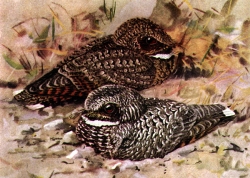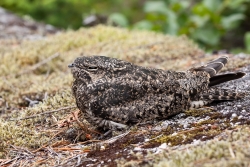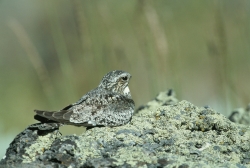
Phalaenoptilus nuttallii
Dusky Poorwill
Phalaenoptilus nuttalli californicus
Courtesy Wikimedia and
Louis Agassiz Fuertes (artist, 1874-1927)
US Copyright expired
 Common Nighthawk
Common NighthawkChordeiles minor
Courtesy Wikimedia and
Gavin Keefe Schaefer, Photographer
Licensed under the Creative Commons Attribution 2.0 Generic license
 Common Nighthawk
Common NighthawkChordeiles minor
Courtesy US FWS and
Dave Menke, Photographer
Hi, I’m Holly Strand.
Citizen Science networks are proliferating across the globe. These networks conduct important research that could not otherwise be accomplished –And they do it using nonprofessional, mostly volunteer labor. An army of civilian data collectors can capture more data over a larger area at a relatively small cost. Aside from collecting data, participants can generate ideas, and help coordinate various aspects of a particular program. Many citizen-driven networks collectenvironmental data at prescribed locations. Wielding Smartphones with GPS receivers, anyonecan instantaneously and accurately determine their geographic coordinates to submit along with their observations.
The Audubon’s Society Christmas Bird Count is one of the oldest and most successful examples of citizen science networks. Since 1900 volunteers have been collecting information about local populations of birds. More recent examples include FrogWatch USA (for observing frogs and toads) Project BudBurst (for observing the leafing and flowering of plants in relation to changing weather patterns) and the World Water Monitoring Challenge (for observing water quality indicators).
One project that recently piqued my interest is the US Nightjar Survey Network coordinated by The Center for Conservation Biology in Virginia.
“What in the world is a nightjar?” you might ask. “Is it something you take camping so you don’t have to get out of the tent?” No. A Nightjar is a medium-sized plump-looking bird withlong wings, a broad head and a very short bill. Nightjars have short legs in relation to their bodies. So they aren’t great at walking. They are exceptional fliers though , catching moths and other insects in mid-flight.
Nightjars are very hard to see because of their camouflage plumage and because they are mostly active after sunset and before sunrise. Thus, you’d want to memorize their very distinctive calls if you are going to try to find them.
Two nightjars breed regularly in Utah. We have the common poorwill which sounds like this…[INSERT 3 CALLS OF POORWILL] . That’s the eastern whippoorwill without the whip. Another Utah breeder is the common Nighthawk which sounds like this …[INSERT 3 CALLS OF NIGHTHAWK].
The nightjar survey for Utah and other northern states begins June 27 and runs through July 11, 2012. Individual surveys are easy to perform and do not take more than two hours to complete.Surveyors work at night, when the moon is at least half full. You need to drive, stopping at 10 points along a 9-mile route. At each point, you count all Nightjars seen or heard during a 6-minute period.
To participate in a survey you can sign up for a Pre-existing route or design your own route. There are still many routes left in all parts of Utah.
For pictures of these extremely interesting birds and a link to the remaining Nightjar Surveyroutes go to www.wildaboututah.org
For Wild About Utah, I’m Holly Strand.
Credits:
Images: Courtesy Wikimedia, Louis Agassiz Fuertes, Gavin Keefe Schaefer and Dave Menke, US FWS images.fws.gov
Text: Holly Strand
Sources & Additional Reading:
Cleere, Nigel. 2010. Nightjars: A Guide to Nightjars, Nighthawks, and Their Relatives. Princeton University Press. https://yalepress.yale.edu/yupbooks/book.asp?isbn=9780300074574
National Geographic Education Encyclopedic Entry: Citizen Science. https://education.nationalgeographic.com/encyclopedia/citizen-science/?ar_a=1
[Accessed June 21, 2012]
Woods, Christopher P., Ryan D. Csada and R. Mark Brigham.2005. Common Poorwill (Phalaenoptilus nuttallii), The Birds of North America Online (A. Poole, Ed.). Ithaca: Cornell Lab of Ornithology; Retrieved from the Birds of North America Online: https://bna.birds.cornell.edu/bna/species/032
United States Nightjar Survey Network (Center for Conservation Biology), https://www.nightjars.org/about/center-for-conservation-biology/
Utah Nightjar Survey Routes (Center for Conservation Biology), https://www.nightjars.org/about/center-for-conservation-biology/
Bird Song Recordings:
Common Poorwill links from WildSoundscape.org recordings collection at the University of Utah
Common Poorwill Phalaenoptilus nuttallii : Nathan Pieplow, XC11631. Accessible at www.xeno-canto.org/11631
Buff-collared Nightjar links from WildSoundscape.org recordings collection at the University of Utah 3 selections
Common Nighthawk Chordeiles minor ; Andrew Spencer, XC14400. Accessible at www.xeno-canto.org/14400
